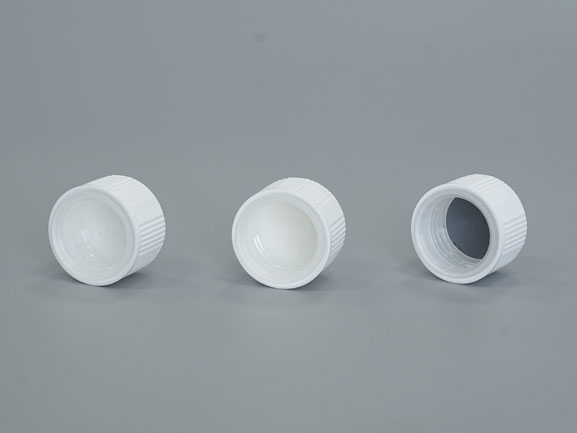In phamaceutical packaging, sealing is undoubtedly one of the important factors affecting drug quality and safety. Especially for oral liquid drugs, due to their high sensitivity to the external environment, proper sealing can not only extend the shelf life of the drug, but also ensure that the efficacy of the drug is not affected by oxidation, moisture or light. Among many packaging solutions, polypropylene child-resistant caps, as a commonly used bottle cap type, have become the first choice for many drug packaging due to their reliable sealing performance. This article will deeply explore the important impact of the structural design and gasket selection of oral liquid medicinal polypropylene screw caps on drug packaging, and provide some optimization suggestions for pharmaceutical companies.

PP 28mm cap with gasket
1. Advantages and structure of polypropylene child-resistant caps
Polypropylene child-resistant caps (PP caps) are a common type of bottle caps, widely used in the packaging of oral liquid drugs. Its main advantage is the light weight and high toughness of polypropylene material, which makes it both strong and effective in resisting external pressure. The child-resistant cap is usually tightly connected to the bottle mouth in a rotating manner to ensure the sealing and anti-counterfeiting properties of the drug packaging.
In addition to the external material, the internal structure of the polypropylene child-resistant cap also helps to improve the sealing performance. Child-resistant caps are usually designed with built-in cap gaskets to form a good seal with the bottle mouth when the bottle cap is tightened. This design makes the sealing gasket play a vital role. It can effectively fill the gap between the bottle mouth and the cap, prevent the entry of foreign substances, and reduce the risk of drug contamination due to poor sealing.
HDPE syrup bottle with crc cap
2. Selection and application of gasket type
The sealing performance of child-resistant caps depends largely on the selected gasket material. Gaskets of different materials not only have different physical and chemical properties, but also can adapt to different bottle and drug requirements. The following are several common gasket types and their characteristics:
1. Low-density polyethylene (LDPE) gasket: Low-density polyethylene gaskets are widely used in oral liquid drug packaging in plastic bottles due to their softness and compressibility. Due to the thin plastic bottle body, LDPE gaskets can effectively fill the gap between the bottle mouth and the bottle cap to ensure the sealing effect while avoiding damage to the bottle body. Its excellent moisture resistance can prevent moisture penetration and protect drugs from moisture.
2. Silicone gasket: Silicone gaskets are often used in drug packaging that requires high temperature resistance and chemical stability. Silicone gaskets can maintain good elasticity and sealing under high and low temperature conditions, and will not be corroded by most chemicals. This makes silicone gaskets very suitable for drugs that need to be stored for a long time, especially some drugs that are easily oxidized and sensitive to heat.
3. Aluminum foil heat-sealed gaskets: For photosensitive or oxidation-sensitive drugs, aluminum foil heat-sealed gaskets provide a perfect solution. Aluminum foil materials not only have good barrier properties to prevent air and moisture penetration, but also effectively block light and protect drugs from the effects of light. Through heat sealing technology, aluminum foil gaskets can be firmly combined with the bottle mouth to provide a safer and more reliable sealing effect.
4. Rubber gaskets: As a traditional gasket choice, rubber gaskets have a wide range of application scenarios. It can produce a good match with the glass bottle body and provide a stable sealing performance. The various formulas of natural rubber and synthetic rubber make it have strong corrosion resistance and elasticity, which is suitable for the packaging needs of a variety of drugs. Especially in an environment with large temperature and pressure changes, rubber gaskets can maintain a good sealing effect to ensure the safety of drugs.
28mm child resistant cap for liquid
3. Optimization of pharmaceutical packaging and market competition
In pharmaceutical packaging design, it is crucial to choose a suitable combination of polypropylene screw caps and gaskets. Pharmaceutical companies should consider the characteristics of the drug, the material of the bottle, and the long-term storage conditions, and choose suitable gasket materials. For example, for liquid drugs that need to be stored stably for a long time, it is recommended to use silicone gaskets to ensure that they can maintain effective sealing under various extreme conditions; and for drugs that are very sensitive to light and air, aluminum foil heat-sealed gaskets are undoubtedly a more suitable choice.
At the same time, reasonable packaging design can also enhance the market competitiveness of drugs. In the increasingly fierce competition in the pharmaceutical packaging market, choosing a suitable closure system and gasket can not only improve the safety and stability of drugs, but also establish a good brand image among consumers.
4. Summary
The choice of gaskets for oral liquid medicinal polypropylene child-resistant opening caps directly affects the sealing and safety of drug packaging. By carefully selecting gasket materials that meet the characteristics of drugs, pharmaceutical companies can ensure the quality and effect of drugs during storage and use. With the continuous advancement of pharmaceutical packaging technology, more innovative gasket materials may appear in the future to provide more complete solutions for pharmaceutical packaging.
Copyright © Shijiazhuang Xinfuda Medical Packaging Co., Ltd. All Rights
MAKE AN ENQUIRY